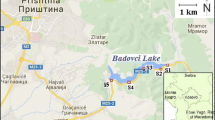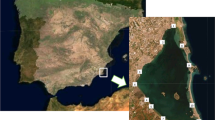Abstract
Water samples collected from two lakes separated from each other by the cascade of four small lowland reservoirs were subjected to analyses in order to compare contamination levels in these ecosystems. Inductively coupled plasma mass spectrometry was used to determine eight elements: Al, As, Cd, Cr, Li, Mn, Sb, and Zn. Statistical methods were applied in order to assess the degree of self-purification of water, during its flow from Swarzędzkie Lake to Malta Lake. Obtained distinctly, lower concentrations of all studied elements in Malta Lake than in Swarzędzkie Lake indicated the role of self-purification processes, which occurred in the distance between these lakes.
Similar content being viewed by others
References
Allan, J. D. (1998). Ecology of running waters. Warsaw: Scientific Publishing PWN SA.
AMAP (1998). AMAP assessment report: Arctic pollution issues. Oslo, Norway: Arctic Monitoring and Assessment Programme (AMAP), XII+.
Barałkiewicz, D., Gramowska, H., Kanecka, A., Krzyżaniak, I., & Gołdyn, R. (2007). Spatial distribution of major and trace elements in the water of Swarzędzkie Lake (Poland). Environmental Monitoring and Assessment, 143, 327–336. doi:10.1007/s10661-007-9935-4.
Bełdowska, M., Falkowska, L., & Lewandowska, A. (2006). Airborne trace metals (Hg, Cd, Pb, Zn) of the coastal region, Gulf of Gdansk. Oceanological and Hydrobiological Studies, 35, 159–169.
Benndorf, J., & Pütz, K. (1987). Control of eutrophication of lakes and reservoirs by means of pre-dams—I. Mode of operation and calculation of the nutrient elimination capacity. Water Research, 21, 829–838. doi:10.1016/0043-1354(87)90159-X.
Benndorf, J., Pütz, K., Krinitz, H., & Henke, W. (1975). Die Funktion der Vorsperren zum Schutz der Talsperren vor Eutrophierung. Wasserwirtschaft Wassertechnik, 25, 19–25.
Bragazza, L. (2006). Heavy metals in bog waters: An alternative way to assess atmospheric precipitation quality? Global and Planetary Change, 53, 290–298. doi:10.1016/j.gloplacha.2006.03.011.
Cheng, W.-d., Zhung, G.-p., Yao, H.-g., Wu, W., & Xu, M. (2006). Genotypic and environmental variation in cadmium, chromium, arsenic, nickel, and lead concentrations in rice grains. Journal of Zhejiang University Science B, 7, 565–571.
Einax, J. W., Truckenbrodt, D., & Kampe, O. (1998). River pollution data interpreted by means of chemometric methods. Microchimica Journal, 58, 315–324. doi:10.1006/mchj.1997.1560.
Gołdyn, R. (1994). The role of preliminary reservoirs in the protection of the Maltański Reservoir. Archiv für Hydrobiologie, Beiheft Ergebnisse der Limnologie, 40, 253–262.
Gołdyn, R. (2000). Changes in biological and physico-chemical parameters of river water quality as a result of its damming in preliminary lowland reservoirs, Seria Biologia 65. Poznań: Adam Mickiewicz University Press.
Gołdyn, R., & Grabia, J. (1998). Protection program of waters in the River Cybina. Poznań: Department of Environmental Protection, Poznań Town’s Authority, [in Polish].
Gołdyn, R., & Szeląg-Wasielewska, E. (2005). The effects of two shallow reservoirs on the phyto- and bacterioplankton of lowland river. Polish Journal of Environmental Studies, 14, 437–444.
Grahn, E., Karlsson, S., & Düker, A. (2006). Sediment reference concentrations of seldom monitored trace elements (Ag, Be, In, Ga, Sb, Tl) in four Swedish boreal lakes—comparison with commonly monitored elements. Science of Total the Environment, 367, 778–790. doi:10.1016/j.scitotenv.2006.01.018.
Hardie, A. M., Heal, K. V., & Lilly, A. (2007). The influence of pedology and changes in soil moisture status on manganese release from upland catchments: Soil core laboratory experiments. Water Air and Soil Pollution, 182, 369–382. doi:10.1007/s11270-007-9348-6.
ISO 5667/4 (1987). Water quality—sampling—part 4: Guidance on sampling from lakes, natural and manmade.
ISO 17294-2 (2003). Water quality—application of inductively coupled plasma mass spectrometry (ICP-MS). Part 2: Determination of 62 elements.
Iwashita, M., & Shimamura, T. (2003). Long-term variations in dissolved trace elements in the Sagami River and its tributaries (upstream area), Japan. Science of the Total Environment, 312, 167–179. doi:10.1016/S0048-9697(03)00251-1.
Jańczak, J. (Ed.) (1996). Atlas of Polish lakes. Inst. Meteorol. Gosp. Wodnej, Poznań: Bogucki Scientific, [in Polish].
Kajak, Z. (1998). Hydrobiology—limnology. Freshwater ecosystems. Warsaw: PWN Scientific, [in Polish].
Kowalczewska-Madura, K. (2003). Mass balance calculations of nitrogen and phosphorus for Swarzędzkie Lake. Limnological Review, 3, 113–118.
Kowalkowski, T., Zbytniewski, R., Szpejna, J., & Buszewski, B. (2006). Application of chemometrics in river water classification. Water Research, 40, 744–752. doi:10.1016/j.watres.2005.11.042.
Kudelska, D., Cydzik, D., & Soszka, H. (1992). Guidelines of basic lake monitoring. Warsaw: State Inspection of Environmental Protection, Library of Environmental Monitoring, [in Polish].
Lamb, J. C. (1985). Water quality and its control. New York: Wiley.
Lambert, R., Grant, C., & Sauve, S. (2007). Cadmium and zinc in soil solution extracts following the application of phosphate fertilizers. Science of the Total Environment, 378, 293–305. doi:10.1016/j.scitotenv.2007.02.008.
Loska, K., & Wiechuła, D. (2003). Application of principal component analysis for the estimation of source of heavy metal contamination in surface sediments from the Rybnik Reservoir. Chemosphere, 8, 723–733. doi:10.1016/S0045-6535(03)00187-5.
Machiwa, P. K. (2003). Water quality management and sustainability: The experience of Lake Victoria Environmental Management Project (LVEMP)—Tanzania. Physics and Chemistry of the Earth, 28, 1111–1115.
Mannio, J. (1995). Survey of trace elements in lake waters of Finnish Lapland using the ICP-MS technique. Science of the Total Environment, 160–161, 433–439. doi:10.1016/0048-9697(95)04376-C.
Mazerski, J. (2000). Podstawy chemometrii, Wyd. Gdańsk: Politechniki Gdańskiej, [in Polish].
Morrison, M. A., & Benoit, G. (2005). Temporal variability in physical speciation of metals during a winter rain-on-snow even. Journal of Environmental Quality, 34, 1610–1619. doi:10.2134/jeq2004.0324.
Müller, J., Ruppert, H., Muramatsu, Y., & Schneider, J. (2000). Reservoir sediments—a witness of mining and industrial development (Malter Reservoir, eastern Erzgebirge, Germany). Environmental Geology, 39, 1341–1351. doi:10.1007/s002540000117.
Nziguheba, G., & Smolders, E. (2008). Inputs of trace elements in agricultural soils via phosphate fertilizers in European countries. Science of the Total Environment, 390, 53–57. doi:10.1016/j.scitotenv.2007.09.031.
Pütz, K., & Benndorf, J. (1998). The importance of pre-reservoirs for the control of eutrophication of reservoirs. Water Science and Technology, 37, 317–324. doi:10.1016/S0273-1223(98)00039-0.
Sabin, L. D., Lim, J. H., Stolzenbach, K. D., & Schiff, K. C. (2005). Contribution of trace metals from atmospheric deposition to stormwater runoff in a small impervious urban catchment. Water Research, 39, 3929–3937. doi:10.1016/j.watres.2005.07.003.
Stachowicz, K., & Czernoch, M. (1992). Ecological characteristic of reservoirs on the Soła River. Warsaw: Inst. Gosp. Przestrz. & Komun., [in Polish].
Statsoft, Inc. (2001). STATISTICA (data analysis software system), version 6. www.statsoft.com.
Straškraba, M., Tundisi, J. G., & Duncan, A. (1993). State-of-the-art of reservoir limnology and water quality management. Developments in Hydrobiology, 77, 213–288.
Striegl, R. G. (1987). Suspended sediment and metals removal from urban runoff by a small lake. Journal of the American Water Resources Association, 23, 985–996. doi:10.1111/j.1752-1688.1987.tb00848.x.
Szyper, H., Gołdyn, R., & Romanowicz, W. (1994). Lake Swarzędzkie and its influence upon the water quality of the River Cybina. Poznańskie Towarzystwo Przyjaciół Nauk, Prace Komisji Biologicznej, 74, 7–31.
Tarvainen, T., Lahermo, P., & Mannio, J. (1997). Sources of trace metals in streams and headwater lakes in Finland. Water Air and Soil Pollution, 94, 1–32.
Wróbel, S., & Bombówna, M. (1976). The cascade type of dam reservoir and the eutrophication. Limnologica, 10, 293–298.
Author information
Authors and Affiliations
Corresponding author
Rights and permissions
About this article
Cite this article
Gramowska, H., Krzyzaniak, I., Baralkiewicz, D. et al. Environmental applications of ICP-MS for simultaneous determination of trace elements and statistical data analysis. Environ Monit Assess 160, 479–490 (2010). https://doi.org/10.1007/s10661-008-0712-9
Received:
Accepted:
Published:
Issue Date:
DOI: https://doi.org/10.1007/s10661-008-0712-9




